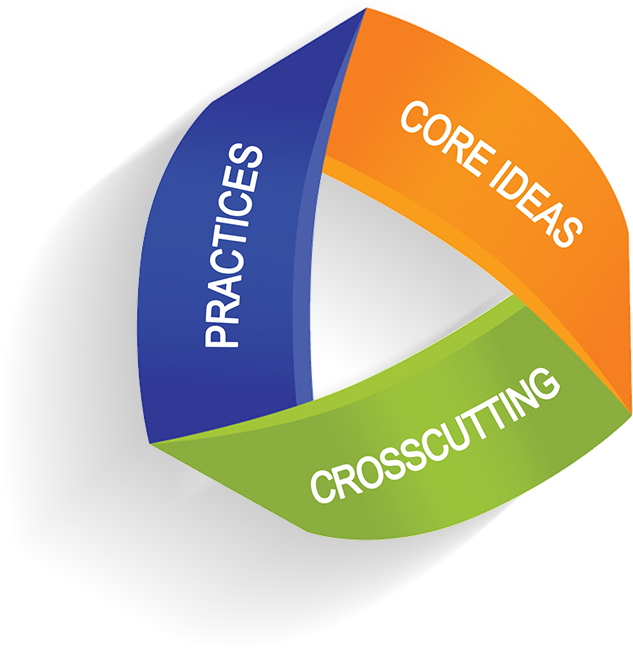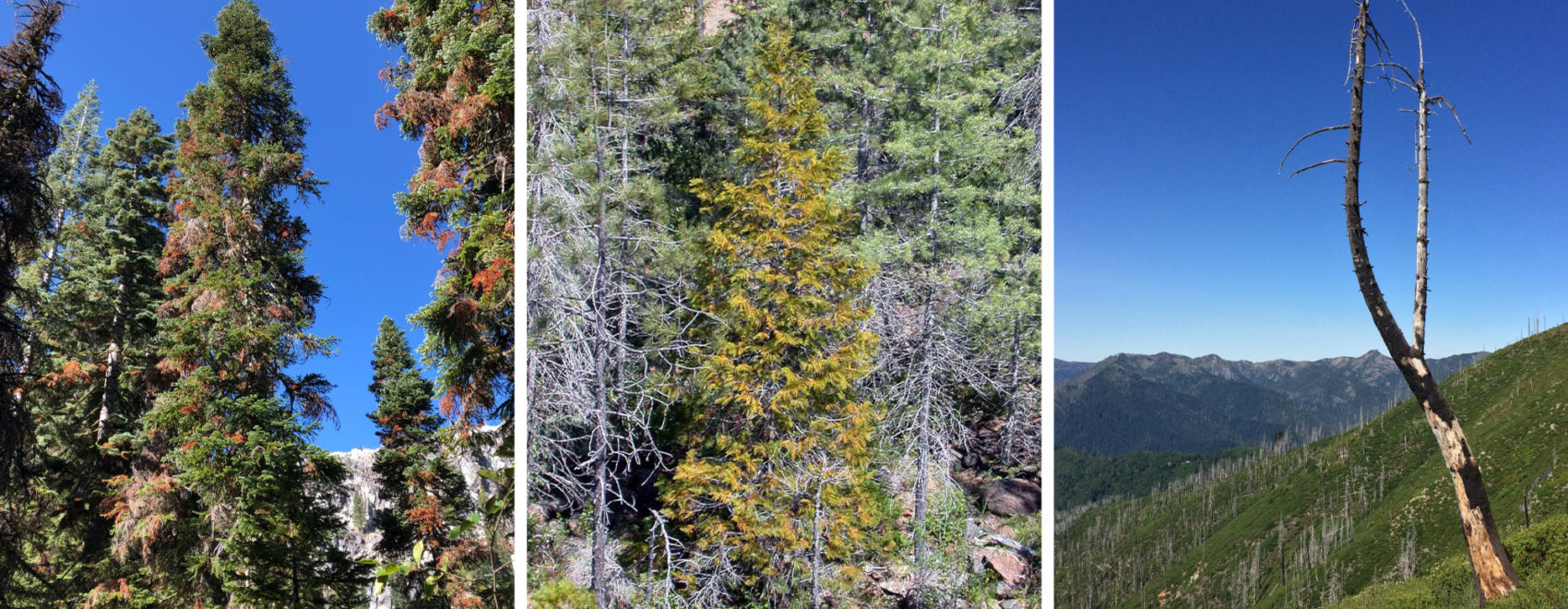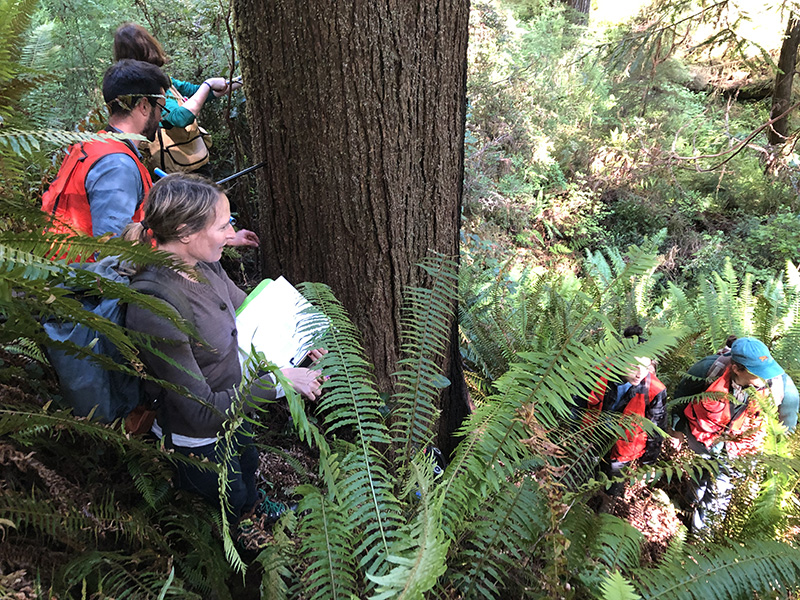Herein is a series of high school lessons (5 days, 50 minutes each) about how conifers in northwest California are responding to drought. Content is based on research conducted by the Cal Poly Humboldt Dendroecology Laboratory.
This unit was created by Michael Kauffmann with funds from the National Science Foundation through Cal Poly Humboldt.

Aligned to the Next Generation Science Standards
Day 1
Northwest California: How Climate Nurtures Diversity
Statement of Inquiry:
Northwest California has complex climate due to a variety of factors including ocean currents and geological complexity. These factors, when considered together, increase regional biodiversity—which is easiest to see and understand through the conifers (cone-bearing trees).
Essential Questions:
- What role does climate play in plant diversity?
Teaching Resources
- Teacher guide (PDF)
- Student handout (PDF)
Overview: Students will gather information on regional climate and interpret how that affects tree diversity in both coastal and mountain environments. Students will demonstrate their understanding by writing about the different requirements of four conifer species (two coastal and two mountain) and the environments in which they grow.
Outline:
Students read through the document, reflect on the reading by answer questions, and share out with a group (small or class) discussion.
Additional Resource: Coniferous Forest
Day 2
The Carbon Cycle
(from the California Academy of Science)
Statement of Inquiry:
How does the finite amount of carbon on this planet move around in the environment, from one place to another? How do the geosphere, biosphere, hydrosphere, and atmosphere interact? In this active demonstration, students will model the carbon cycle, and consider way in which human actions play a role.
Essential Questions:
- What is the carbon cycle?
- How to plants use carbon during photosynthesis?
Teaching Resources
- California Academy of Science website with the curriculum
- Lesson Plan (PDF)
- Roleplay Cards (PDF)
Outline:
Try using the What Contains Carbon? activity as an introduction to carbon and its different forms. If you do not have time for this activity, review with your students that carbon is a common element on earth. Have students recall some of the things in their daily lives that contain carbon. Make a list of these items on the board.
Explain to your students that the carbon contained in any one thing doesn’t stay there forever. The carbon atoms move from one thing to another in what is called the carbon cycle. Parts of the carbon cycle happen very quickly, like when plants take in carbon dioxide from the atmosphere for photosynthesis. But, other parts of the carbon cycle happen very slowly.
Day 3
Carbon Isotopes + Photosynthesis
Statement of Inquiry:
What does it means for an isotope to be radioactive? How does the half-life of carbon-14 allows scientists to date organic materials? It all relates to how carbon is created in the first place: PHOTOSYNTHESIS BABY!
Essential Questions:
- What is an isotope?
- How do carbon isotopes allow us to date objects like tree rings?
- How to plants use carbon during photosynthesis?
Outline:
This lesson involves two independent, yet connected, activities across a 50 minute class period.
- Begin the lesson by watching the 3 minute video about carbon isotopes followed by a discussion about what was learned. DISCUSSION QUESTIONS.
- For the remainder of class explore photosynthesis with your students. Start with the video linked below. It is a 10 minute “cartoon” by the Smithsonian and humorous enough to engage high school students.
- After the video draw and discuss photosynthesis, emphasizing the importance of what is consumed and produced by the plant during the process.
Wrap it up
- Use THIS EXIT TICKET to assess learning and plan for tomorrow’s lesson.
Day 4
Conifer Response to Drought:
Reading and interpreting the data
Statement of Inquiry:
The data has been collected and analyzed. Now it is up to us to decide if trees are drought-stressed, what species these are, and where they live. This will allow us to assess the health of conifers across northwest California.
Essential Questions:
- Which species are experiencing drought stress?
- What is happening in coastal species compared to inland mountain species?
- What do these data mean for tree species’ future with more drought? Less drought?
Teaching Resources
- FILM to introduce students to the data collection process.
- This Guided Student Worksheet (PDF) is all you need to walk your students through understanding this project.
- Student Dataset (EXCEL) is available if you really want to nerd out with your students.
Outline:
Part 1 (5-10 min. with discussion)
- Begin the lesson by watching the 5 minute video with Wallis Robinson, a graduate researcher at the Cal Poly Humboldt Dendroecology Laboratory. She provides an overview of the tree ring data collection process.
- After watching the video, be sure to review questions students may have including the steps in the data collection as well as what a carbon isotope is and how and why plants differentially use them when stressed.
Part 2 (30-40 min. with group work time and discussion)
- The remainder of the class period is for groups of students to work through the Student Data Worksheet. This guided progression takes students through the researcher’s findings and helps them draw their own conclusions.
- Tomorrow, students will watch a video where the researchers interpret the data for them as a comparison.
Day 5
Meet the Professors
Results through the eyes of Dr. Lucy Kerhourlas and Dr. Rosemary Sherriff
Essential Questions:
- What are the final conclusions for the research? Did your data interpretation match this?
- What is happening in coastal species during the drought?
- What is happening to inland mountain species during the drought?
Outline:
Watch the 30 minute video and discuss what you learned with the class.
- DOWNLOAD guiding questions as you watch the video with your class.





Leave a Reply
You must be logged in to post a comment.